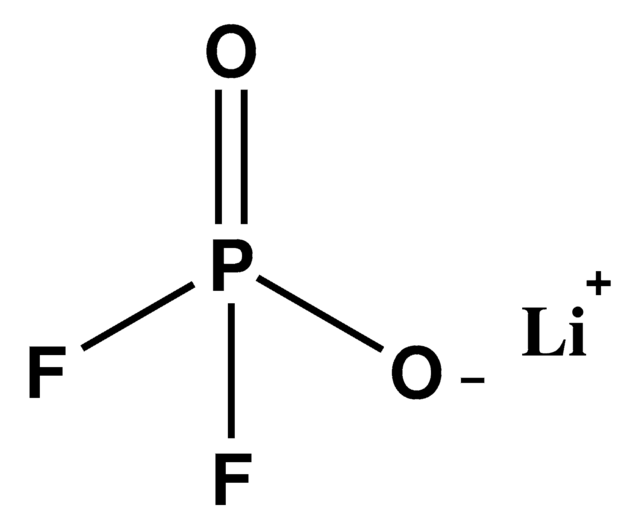935832
Lithium bis(fluorosulfonyl)imide
99.9% trace metals basis, battery grade
Sinonimo/i:
"Imidodisulfuryl fluoride, lithium salt", Ionel LF 101, LiFSI, Lithium bis(fluorosulfonyl)amide, Lithium bis(fluorosulfonyl)imido, Lithium imidodisulfuryl fluoride
About This Item
Prodotti consigliati
Grado
battery grade
Livello qualitativo
Descrizione
Application: Battery manufacturing
Saggio
99.9% trace metals basis
Forma fisica
powder
Caratteristiche più verdi
Design for Energy Efficiency
Learn more about the Principles of Green Chemistry.
sustainability
Greener Alternative Product
Punto di fusione
140 °C
Anioni in tracce
chloride (Cl-): ≤5 ppm
sulfate (SO42-): ≤10 ppm
Cationi in tracce
K: ≤10 ppm
Na: ≤5 ppm
applicazioni
battery manufacturing
Categoria alternativa più verde
Stringa SMILE
FS([N-]S(F)(=O)=O)(=O)=O.[Li+]
InChI
1S/F2NO4S2.Li/c1-8(4,5)3-9(2,6)7;/q-1;+1
VDVLPSWVDYJFRW-UHFFFAOYSA-N
Cerchi prodotti simili? Visita Guida al confronto tra prodotti
Categorie correlate
Descrizione generale
Applicazioni
Prodotti correlati
Avvertenze
Danger
Indicazioni di pericolo
Consigli di prudenza
Classi di pericolo
Acute Tox. 4 Oral - Eye Dam. 1 - Muta. 2 - Skin Irrit. 2
Codice della classe di stoccaggio
11 - Combustible Solids
Classe di pericolosità dell'acqua (WGK)
WGK 3
Punto d’infiammabilità (°F)
Not applicable
Punto d’infiammabilità (°C)
Not applicable
Certificati d'analisi (COA)
Cerca il Certificati d'analisi (COA) digitando il numero di lotto/batch corrispondente. I numeri di lotto o di batch sono stampati sull'etichetta dei prodotti dopo la parola ‘Lotto’ o ‘Batch’.
Possiedi già questo prodotto?
I documenti relativi ai prodotti acquistati recentemente sono disponibili nell’Archivio dei documenti.
Il team dei nostri ricercatori vanta grande esperienza in tutte le aree della ricerca quali Life Science, scienza dei materiali, sintesi chimica, cromatografia, discipline analitiche, ecc..
Contatta l'Assistenza Tecnica.









